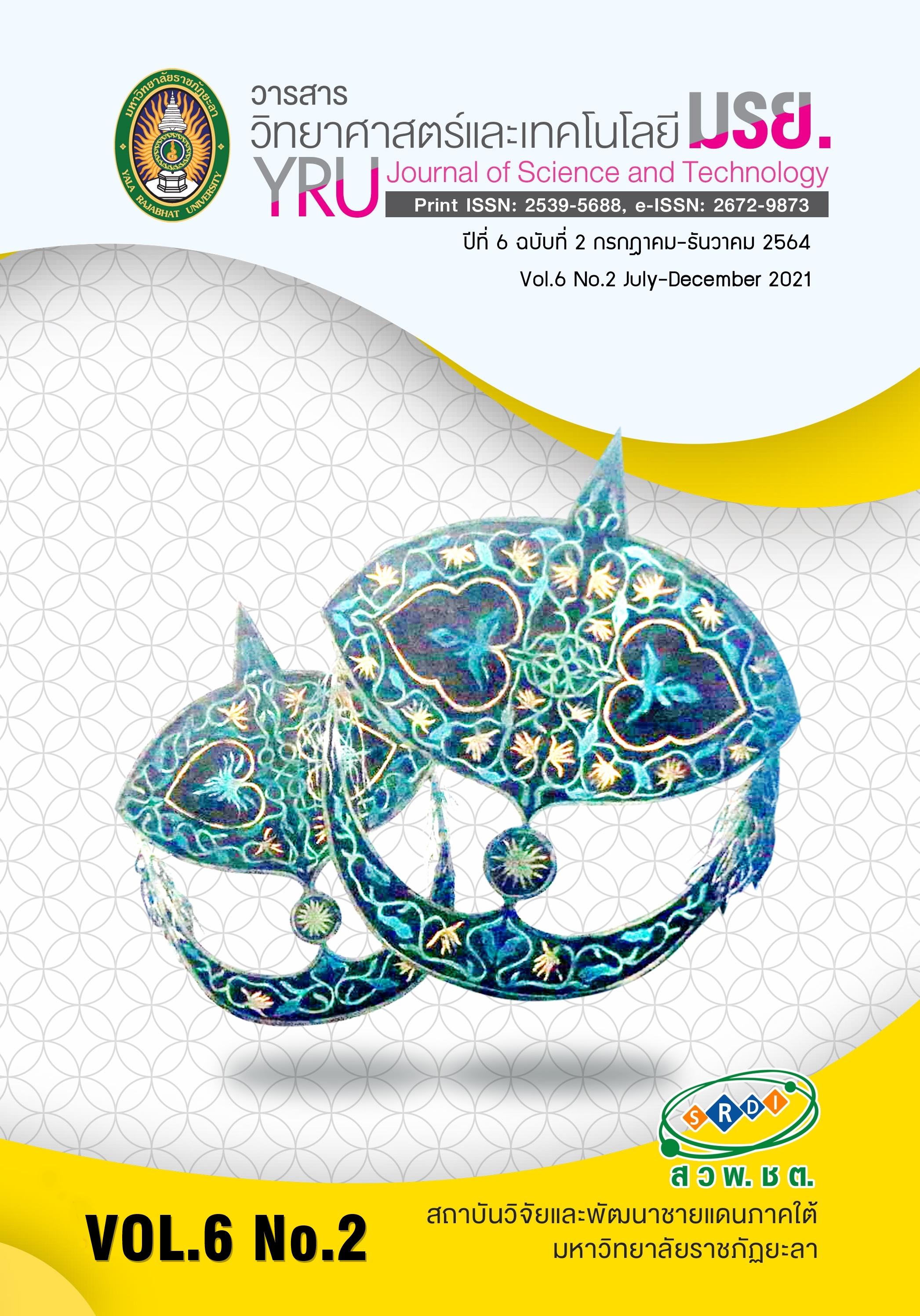องค์ประกอบทางเคมี และฤทธิ์การต้านอนุมูลอิสระจากข้าวพันธุ์พื้นเมือง
Main Article Content
บทคัดย่อ
งานวิจัยนี้เพื่อศึกษาองค์ประกอบทางเคมี ปริมาณฟีนอลิกทั้งหมด ปริมาณฟลาโวนอยด์ทั้งหมด แอนโทไซยานินทั้งหมด และฤทธิ์การต้านอนุมูลอิสระ โดยวิธี DPPH assay, ABTS radical scavenging activity, ความสามารถใน การรีดิวซ์ และความสามารถในการยับยั้งการเกิด lipid peroxidation ตามลำดับ จากข้าวพันธุ์พื้นเมือง 14 สายพันธุ์ พบว่า ข้าวไรซ์เบอรี่ และข้าวเหนียวดำมีองค์ประกอบทางเคมีได้แก่ ปริมาณความชื้นและโปรตีนสูงที่สุด แต่มีปริมาณเถ้า และไขมันต่ำที่สุด และข้าวเหนียวดำ และ ข้าวไรซ์เบอรี่มีปริมาณฟีนอลิกทั้งหมด ปริมาณฟลาโวนอยด์ทั้งหมด และแอนโทไซยานินทั้งหมดสูง เมื่อวิเคราะห์ฤทธิ์การต้านอนุมูลอิสระ พบว่า ข้าวไรซ์เบอรี่มีฤทธิ์ยับยั้งทุกระบบมากที่สุดผลการทดลองแสดง ให้เห็นถึงความสัมพันธ์ของปริมาณฟีนอลิกทั้งหมด ปริมาณฟลาโวนอยด์ทั้งหมด แอนโทไซยานินทั้งหมด และฤทธิ์การต้านอนุมูลอิสระเพื่อเป็นทางเลือกในบริโภคข้าวและพัฒนาเป็นอาหารเสริม
Article Details
บทความ ข้อมูล เนื้อหา รูปภาพ ฯลฯ ที่ได้รับการเผยแพร่ในวารสารวิทยาศาสตร์และเทคโนโลยี มรย. นี้ ถือเป็นลิขสิทธิ์ของวารสารวิทยาศาสตร์และเทคโนโลยี มรย. หากบุคคลหรือหน่วยงานใดต้องการนำทั้งหมดหรือส่วนหนึ่งส่วนใดไปเผยแพร่ต่อหรือกระทำการใดๆ จะต้องได้รับอนุญาตเป็นลายลักษณ์อักษรจากวารสารวิทยาศาสตร์และเทคโนโลยี มรย. ก่อนเท่านั้น
เอกสารอ้างอิง
AOAC (Association of official Analytical I Chemists). (2012). Official Methods of Analysis. Association of Official Analytical I Chemists, Arlington.
Arvouet-Grand, A., Vennat, B., Pourrat, A. & Legret, P. (1994). Standardization of propolis extract and identification of principal constituents. Journal de pharmacie de Belgique, 49, 462–468.
Benzie, I.F. & Strain, J.J. (1996). The ferric reducing ability of plasma (FRAP) as a measure of antioxidant power: the FRAP assay. Analytical Biochemistr, 239(1), 70-76.
Brand-Williams, W., Cuvelier, M. E. & Berset, C. (1995). Use of a free radical method to evaluate antioxidant activity. Lebens-Wiss Technol, 28, 25-30.
Buachoon, N. & Manjit, W. (2018). Quantitation of total phenolic antioxidant activity and development of skin care lotion. VRU Research and Development Journal Science and Technology, 13(2), 78-95. (in Thai)
Delgado-Andrade, C., Rufián-Henares, J. A., & Morales, F. J. (2005). Unraveling the contribution of melanoidins to the antioxidant activity of coffee brews. Journal of Agricultural and Food Chemistry, 53, 1403-1407.
Department of Science Service. (2010). Anthocyanin. Bangkok: Ministry of Science and Technology.
(in Thai)
Goffman, F.D. & Bergman, C.J. (2004). Rice kernel phenolic content and its relationship with antiradical efficiency. Journal of the Science of Food and Agriculture, 84(10), 1235-1240.
Goufo, P. & Trindade, H. (2013). Rice antioxidants: phenolic acids, flavonoids, anthocyanins, proanthocyanidins, tocopherols, tocotrienols, γ-oryzanol, and phytic acid. Food science and nutrition, 2(2), 75-104.
Henry, R.J. & Kettlewell, R.S. (1996). Cereal Grain Quality. Chapman & Hall. USA.
Hoseney, R. C. (1986). Principles of Cereal Science and Technology. Cereal Chemistry, 63(3), 285-286.
Juliano, B.O. (1993). Rice in human nutrition. Rome: The Collaboration of the International Rice Research Institute Publications.
Lei, Y., Lim, Y.Y., & Tan, S.P. (2009). Antioxidative, Tyrosinase Inhibiting and Antibacterial Activities of Leaf Extracts from Medicinal Ferns. Bioscience, Biotechnology, and Biochemistry, 73(6), 1362-1371.
Majhenic L, kerget MS, & Knez Z. (2007). Antioxidant and antimicrobial activity of guarana seed extracts. Food Chemistry, 104, 1258-1268.
Mi-Yae, S., Tae-Hun, K. & Nak-Ju, S. (2003). Antioxidant and free radical scavenging activity of Phellinus baumii (Phellinus of Hymenochaetaceae) extracts. Food Chemistry, 882, 593-597.
Moko, E. M., Purnomo, H., Kusnadi, J., & Ijong, F.G. (2014). Phytochemical content and antioxidant properties of colored and non colored varieties of rice bran from Minahasa, North Sulawesi, Indonesia. International Food Research Journal, 21(3), 1053-1059.
Nakornriab, M. & Srihanam, P. (2010) Study on total phenoliccContents and their antioxidant activity of thai white, red and black rice bran extracts. Pakis Journal of Biological Science, 13(4), 170-174.
Ranganna S. (1986). Handbook of Analysis and Quality Control for Fruit and Vegetable Products. Tata McGraw-Hill Publishing Company, New Delhi, India.
Rattanachaisit, P. & Kongkiattikajorn, J. (2015). Antioxidative activities of bran extracts from pigmented rice cultivars. The International Conference on Herbal and Traditional Medicine, 11, 33-42.
Sawaddiwong, S., Jongjareonrak, A. and Benjakul, S. (2008). Phenolic content and antioxidant activity of germinated brown rice as affected by germination temperature and extraction solvent. In Proceeding of 34th Congress on Science and Technology of Thailand of Thailand. 31 October-2 November. 2008. Bangkok.
Zhou, Z., Robards, K., Helliwell, S., & Blanchard, C., (2002). Ageing of stored rice: changes in chemical and physical attributes. Journal of Cereal Science. 35(1), 65-78.
Yawadio R., Tanimori S. and Morita N. (2007). Identification of Phenolic compounds isolated from pigmented rices and their aldose reductase inhibitory activities. Food Chemistry, 101, 1616-1625.


